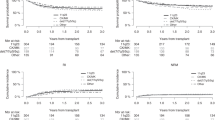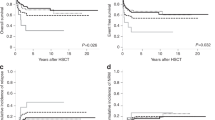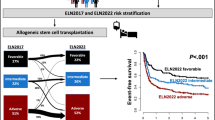Abstract
Among patients with myelodysplastic syndrome (MDS) undergoing hematopoietic cell transplantation (HCT), the impact of residual pretransplant cytogenetically abnormal cells on outcomes remains uncertain. We analyzed HCT outcomes by time of transplant disease variables, including (1) blast percentage, (2) percentage of cytogenetically abnormal cells and (3) Revised International Prognostic Scoring System (R-IPSS) cytogenetic classification. We included 82 MDS patients (median age 51 years (range 18–71)) transplanted between 1995 and 2013 with abnormal diagnostic cytogenetics. Patients with higher percentages of cytogenetically abnormal cells experienced inferior 5-year survival (37–76% abnormal cells: relative risk (RR) 2.9; 95% confidence interval (CI) 1.2–7.2; P=0.02; and 77–100% abnormal cells: RR 5.6; 95% CI 1.9–19.6; P<0.01). Patients with >10% blasts also had inferior 5-year survival (RR 2.9; 95% CI 1.1–7.2; P=0.02) versus patients with ⩽2% blasts. Even among patients with ⩽2% blasts, patients with 77–100% cytogenetically abnormal cells had poor survival (RR 4.4; 95% CI 1.1–18.3; P=0.04). Increased non-relapse mortality (NRM) was observed with both increasing blast percentages (P<0.01) and cytogenetically abnormal cells at transplant (P=0.01) in multivariate analysis. We observed no impact of disease burden characteristics on relapse outcomes due to high 1-year NRM. In conclusion, both blast percentage and percentage of cytogenetically abnormal cells reflect MDS disease burden and predict post-HCT outcomes.
This is a preview of subscription content, access via your institution
Access options
Subscribe to this journal
Receive 12 print issues and online access
$259.00 per year
only $21.58 per issue
Buy this article
- Purchase on Springer Link
- Instant access to full article PDF
Prices may be subject to local taxes which are calculated during checkout


Similar content being viewed by others
References
Tefferi A, Vardiman JW . Myelodysplastic syndromes. N Engl J Med 2009; 361: 1872–1885.
Greenberg P, Cox C, LeBeau MM, Fenaux P, Morel P, Sanz G et al. International scoring system for evaluating prognosis in myelodysplastic syndromes. Blood 1997; 89: 2079–2088.
Greenberg PL, Tuechler H, Schanz J, Sanz G, Garcia-Manero G, Sole F et al. Revised international prognostic scoring system for myelodysplastic syndromes. Blood 2012; 120: 2454–2465.
Cutler CS, Lee SJ, Greenberg P, Deeg HJ, Perez WS, Anasetti C et al. A decision analysis of allogeneic bone marrow transplantation for the myelodysplastic syndromes: delayed transplantation for low-risk myelodysplasia is associated with improved outcome. Blood 2004; 104: 579–585.
Koreth J, Pidala J, Perez WS, Deeg HJ, Garcia-Manero G, Malcovati L et al. Role of reduced-intensity conditioning allogeneic hematopoietic stem-cell transplantation in older patients with de novo myelodysplastic syndromes: an international collaborative decision analysis. J Clin Oncol 2013; 31: 2662–2670.
Damaj G, Duhamel A, Robin M, Beguin Y, Michallet M, Mohty M et al. Impact of azacitidine before allogeneic stem-cell transplantation for myelodysplastic syndromes: a study by the societe francaise de greffe de moelle et de therapie-cellulaire and the groupe-francophone des myelodysplasies. J Clin Oncol 2012; 30: 4533–4540.
Della Porta MG, Alessandrino EP, Bacigalupo A, van Lint MT, Malcovati L, Pascutto C et al. Predictive factors for the outcome of allogeneic transplantation in patients with MDS stratified according to the revised IPSS-R. Blood 2014; 123: 2333–2342.
Cheson BD, Greenberg PL, Bennett JM, Lowenberg B, Wijermans PW, Nimer SD et al. Clinical application and proposal for modification of the international working group (IWG) response criteria in myelodysplasia. Blood 2006; 108: 419–425.
Vardiman JW, Thiele J, Arber DA, Brunning RD, Borowitz MJ, Porwit A et al. The 2008 revision of the World Health Organization (WHO) classification of myeloid neoplasms and acute leukemia:rationale and important changes. Blood 2009; 114: 937–951.
Majhail NS, Brunstein CG, Shanley R, Sandhu K, McClune B, Oran B et al. Reduced-intensity hematopoietic cell transplantation in older patients with AML/MDS: umbilical cord blood is a feasible option for patients without HLA-matched sibling donors. Bone Marrow Transplant 2012; 47: 494–498.
Warlick ED, Tomblyn M, Cao Q, Defor T, Blazar BR, Macmillan M et al. Reduced-intensity conditioning followed by related allografts in hematologic malignancies: long-term outcomes most successful in indolent and aggressive non-hodgkin lymphomas. Biol Blood Marrow Transplant 2011; 17: 1025–1032.
Ustun C, Wiseman AC, Defor TE, Yohe S, Linden MA, Oran B et al. Achieving stringent CR is essential before reduced-intensity conditioning allogeneic hematopoietic cell transplantation in AML. Bone Marrow Transplant 2013; 48: 1415–1420.
Kaplan EL, Meier P . Nonparametric estimation from incomplete observations. J Am Stat Assoc 1958; 53: 457–481.
Lin DY . Non-parametric inference for cumulative incidence functions in competing risks studies. Stat Med 1997; 16: 901–910.
Gray R . A class of K-sample tests for comparing the cumulative incidence of a competing risk. Ann Stat 1988; 16: 1141–1154.
Tarone RE . Tests for trend in life table analysis. Biometrika 1975; 62: 679–682.
Cox DR . Regression models and life tables. J Royal Stat Soc B 1972; 34: 187–220.
Fine JP, Gray RJ . A proportional hazards model for the sub-distribution of a competing risk. J Am Stat Assoc 1999; 94: 496–509.
Colett D . Modelling Survival Data in Medical Research, Chapman & Hall/CRC, London, UK, 2003.
LeBlanc M, Crowley J . Relative risk trees for censored survival data. Biometrics 1992; 48: 411–425.
Bozdogan H . Model selection and Akaike’s information criterion (AIC): the general theory and its analytical extensions. Phychometrika 1987; 52: 345–370.
Warlick ED, Cioc A, DeFor T, Dolan M, Weisdorf D . Allogeneic stem cell transplantation for adults with myelodysplastic syndromes: importance of pretransplant disease burden. Biol Blood Marrow Transplant. 2009; 15: 30–38.
Ustun C, Trottier BJ, Sachs Z, DeFor TE, Shune L, Courville EL et al. Monosomal karyotype at the time of diagnosis or transplantation predicts outcomes of allogeneic hematopoietic cell transplantation in myelodysplastic syndrome. Biol Blood Marrow Transplant 2015; 21: 866–872.
Deeg HJ, Scott BL, Fang M, Shulman HM, Gyurkocza B, Myerson D et al. Five-group cytogenetic risk classification, monosomal karyotype, and outcome after hematopoietic cell transplantation for MDS or acute leukemia evolving from MDS. Blood 2012; 120: 1398–1408.
Bejar R, Stevenson K, Abdel-Wahab O, Galili N, Nilsson B, Garcia-Manero G et al. Clinical effect of point mutations in myelodysplastic syndromes. N Engl J Med 2011; 364: 2496–2506.
Bejar R, Stevenson KE, Caughey B, Coleman Lindsley R, Mar BG, Stojanov P et al. Somatic mutations predict poor outcome in patients with myelodysplastic syndrome after hematopoietic stem-cell transplantation. J Clin Oncol 2014; 32: 2691–2697.
Acknowledgements
This study received funding from the National Institute of Health T32 Training Grant (to BJT and ZS). This work was supported in part by grants from the National Cancer Institute P01 CA65493 (to TED).
Author information
Authors and Affiliations
Corresponding author
Ethics declarations
Competing interests
The authors declare no conflict of interest.
Additional information
Supplementary Information accompanies this paper on Bone Marrow Transplantation website
Supplementary information
Rights and permissions
About this article
Cite this article
Trottier, B., Sachs, Z., DeFor, T. et al. Novel disease burden assessment predicts allogeneic transplantation outcomes in myelodysplastic syndrome. Bone Marrow Transplant 51, 199–204 (2016). https://doi.org/10.1038/bmt.2015.274
Received:
Revised:
Accepted:
Published:
Issue Date:
DOI: https://doi.org/10.1038/bmt.2015.274
This article is cited by
-
Indications for Allogeneic Hematopoietic Cell Transplantation in Myelodysplastic Syndrome
Current Hematologic Malignancy Reports (2020)
-
Myeloablative conditioning regimens with combined of haploidentical and cord blood transplantation for myelodysplastic syndrome patients
Bone Marrow Transplantation (2018)
-
Impending relapse of myelodysplastic syndrome after allogeneic transplant is difficult to diagnose and requires a multi-modal approach
BMC Clinical Pathology (2017)
-
MDS disease characteristics, not donor source, predict hematopoietic stem cell transplant outcomes
Bone Marrow Transplantation (2017)
-
Individual outcome prediction for myelodysplastic syndrome (MDS) and secondary acute myeloid leukemia from MDS after allogeneic hematopoietic cell transplantation
Annals of Hematology (2017)



